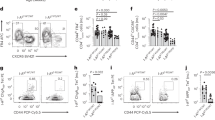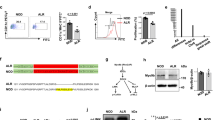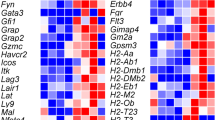Abstract
Type 1, or insulin-dependent diabetes mellitus (IDDM) is an autoimmune disease associated with loss of tolerance to several pancreatic islet cell molecules, including insulin, glutamic acid decarboxylase (GAD), ICA69 and the tyrosine phosphatase IA-2 (refs 1–3). Among several predisposing loci, IDDM2 maps to the insulin gene (INS) VNTR (variable number of tandem repeats) minisatellite on chromosome 11p15 (refs 4–9). Allelic variation at this VNTR locus correlates with steady-state levels of INS mRNA in pancreas8,10–11 and transfected rodent cell lines12,14, but it is difficult to reconcile the association of lower INS mRNA levels in the pancreas with class III VNTRs that are dominantly protective from IDDM8,15. We show that during fetal development and childhood, mRNAs for insulin and other islet cell autoantigens (GAD, ICA69, IA-2) are expressed at low levels in the human thymus. Critically, we also detect proinsulin and insulin protein. VNTR alleles correlate with differential INS mRNA expression in the thymus where, in contrast to the pancreas, protective class III VNTRs are associated with higher steady-state levels of INS mRNA expression. This finding provides a plausible explanation for the dominant protective effect of class III VNTRs, and suggests that diabetes susceptibility and resistance associated with IDDM2 may derive from the VNTR influence on INS transcription in the thymus. Higher levels of (pro)insulin in the thymus may promote negative selection (deletion) of insulin-specific T-lymphocytes which play a critical role in the pathogenesis of type-1 diabetes.
This is a preview of subscription content, access via your institution
Access options
Subscribe to this journal
Receive 12 print issues and online access
$209.00 per year
only $17.42 per issue
Buy this article
- Purchase on Springer Link
- Instant access to full article PDF
Prices may be subject to local taxes which are calculated during checkout
Similar content being viewed by others
References
Atkinson, M.A. & Maclaren, N.K. The pathogenesis of insulin-dependent diabetes mellitus. New Engl. J. Med. 331, 1428–1436 (1994).
Pietropaolo, M. et al. Islet cell autoantigen 69 kDa (ICA69): molecular cloning and characterization of a novel diabetes associated autoantigen. J. Clin. Invest. 92, 359–371 (1993).
Rabin, D.U. et al. Islet cell antigen 512 is a diabetes-specific islet autoantigen related to protein tyrosine phosphatases. J. Immunol. 152, 3183–3188 (1994).
Bell, G.I. Horita, S. & Karam, J.H. A polymorphic locus near the human insulin gene is associated with insulin dependent diabetes mellitus. Diabetes 33, 176–183 (1984).
Julier, C. et al. Insulin-IGF2 region encodes a gene implicated in HLA-DR4-dependent diabetes susceptibility. Nature 354, 155–159 (1991).
Lucassen, A. et al. Susceptibility to insulin dependent diabetes mellitus maps to a 4.1-kb segment of DNA spanning the insulin gene and associated VNTR. Nature Genet. 4, 305–310 (1993).
Owerbach, D. & Gabbay, K.H. Localization of a Type I diabetes susceptibility locus to the variable tandem repeat region flanking the insulin gene. Diabetes 42, 1708–1714 (1993).
Bennett, S.T. et al. Susceptibility to human type 1 diabetes at IDDM2 is determined by tandem repeat variation at the insulin gene minisatellite locus. Nature Genet. 9, 284–292 (1995).
Undlien, D.E. et al. Insulin gene region-encoded susceptibility to IDDM maps upstream of the insulin gene. Diabetes 44, 620–625 (1995).
Bennett, S.T. et al. IDDM2-VNTR-encoded susceptibility to type 1 diabetes: dominant protection and parental transmission of alleles of the insulin gene-linked minisatellite locus. J. Autoimmun. 9, 415–421 (1996).
Vafiadis, P. et al. Imprinted and genotype-specific expression of genes at the IDDM2 locus in pancreas and leucocytes. J. Autoimmun. 9, 397–403 (1996).
Catignani Kennedy, G. German, M.S. & Rutter, W.J. The minisatellite in the diabetes susceptibility locus IDDM2 regulates insulin transcription. Nature Genet. 9, 293–298 (1995).
Lucassen, A.M. Screaton, G.R. Julier, C. Elliott, T.J. Lathrop, M. & Bell, J.I. Regulation of insulin gene expression by the IDDM associated, insulin locus haplotype. Hum. Mol. Genet. 4, 501–506 (1995).
Owerbach, D. & Gabbay, K.H. The search for IDDM susceptibility genes. Diabetes 45, 544–551 (1996).
Pugliese, A. Awdeh, Z.L. Alper, C.A. Jackson, R.A. & Eisenbarth, G.S. The paternally inherited insulin gene B allele (1,428 Fokl site) confers protection from insulin-dependent diabetes in families. J. Autoimmun. 7, 687–694 (1994).
Bell, G.I. Selby, M.J. & Rutter, W.J. The highly polymorphic region near the insulin gene is composed of simple tandemly repeating sequences. Nature 295, 31–35 (1982).
Jolicouer, C. Hanahan, D. & Smith, K.M. T-cell tolerance toward a transgenic betacell antigen and transcription of endogenous pancreatic genes in thymus. Proc. Natl. Acad. Sci. USA 91, 6707–6711 (1994).
Oehen, S.U. et al. Escape of thymocytes and mature T cells from clonal deletion due to limiting tolerogen expression levels. Cell. Immunol. 158, 342–352 (1994).
Sebzda, E. et al. Positive and negative thymocyte selection induced by different concentrations of a single peptide. Science 263, 1615–1618 (1994).
Kuglin, B. Gries, F.A. & Kolb, H. Evidence for IgG autoantibodies against human proinsulin in patients with IDDM before insulin treatment. Diabetes 37, 130–132 (1988).
Castano, L. Ziegler, A. Ziegler, R. Shoelson, S. & Eisenbarth, G.S. Characterization of insulin autoantibodies in relatives of patients with insulin-dependent diabetes mellitus. Diabetes 42, 1202–1209 (1993).
Griffin, A.C. Zhao, W. Wegmann, K.W. & Hickey, W.F. Experimental autoimmune insulitis. Induction by T lymphocytes specific for a peptide of proinsulin. Am. J. Path. 147, 845–857 (1995).
Keilacker, H. Rjasanowski, I. Besch, W. & Kohnert, K.D. Autoantibodies to insulin and to proinsulin in type 1 diabetic patients and in at-risk probands differentiate only little between both antigens. Hormone Metab. Res. 27, 90–94 (1995).
French, M.B. et al. Transgenic expression of mouse proinsulin II prevents diabetes in nonobese diabetic mice. Diabetes 46, 34–39 (1997).
Vafiadis, P. et al. Insulin expression in human thymus is modulated by INS VNTR alles at the IDDM2 locus. Nature Genet. 15, 289–292 (1997).
Bennett, S.T. & Todd, J.A. Human type 1 diabetes and the insulin gene: Principles of mapping polygenes. Ann. Rev. Genet. 30, 343–370 (1996).
Hoffman, A.R. & Vu, T.H. Sci. Am. 1, 52–61 (1996).
Polychronakos, C. Kukuvitis, A. Giannoukakis, N. & Colle, E. Parental imprinting effect at the INS-IGF2 diabetes susceptibility locus. Diabetologia 38, 715–719 (1995).
Bui, M.M. et al. Paternally transmitted IDDM2 influences diabetes susceptibility despite biallelic expression of the insulin gene in human pancreas. J. Autoimmun. 9, 97–103 (1996).
Vu, T.H. Hoffman, A.R. Promoter-specific imprinting of the human insulin-like growth factor-II gene. Nature 371, 714–717 (1994).
Xu, Y. Goodyear, C.G. Deal, C. & Polychronakos, C. Functional polymorphism in the parental imprinting of the human IGF2R gene. Biochem. Biophys. Res. Comm. 197, 747–754 (1993).
Mally, M.J. Cirulli, V. Hayek, A. Otonkoski, T. ICA69 is expressed equally in the human endocrine and exocrine pancreas. Diabetologia 39, 474–480 (1996).
Lan, M.S. Goto, J.L. Notkins, A.L. Molecular cloning and identification of a receptor-type protein tyrosine phosphatase, IA-2, from human insulinoma. DNA Cell Biol. 13, 505–514 (1994).
Devaskar, S.U. Singh, B.S. Carnaghi, L.R. Rajakumar, P.A. Giddings & S.J. Insulin II gene expression in rat central nervous system. Reg. Peptides 48, 55–63 (1993).
Author information
Authors and Affiliations
Corresponding author
Rights and permissions
About this article
Cite this article
Pugliese, A., Zeller, M., Fernandez, A. et al. The insulin gene is transcribed in the human thymus and transcription levels correlate with allelic variation at the INS VNTR-IDDM2 susceptibility locus for type 1 diabetes. Nat Genet 15, 293–297 (1997). https://doi.org/10.1038/ng0397-293
Received:
Accepted:
Issue Date:
DOI: https://doi.org/10.1038/ng0397-293
This article is cited by
-
Emerging therapeutic options in the management of diabetes: recent trends, challenges and future directions
International Journal of Obesity (2023)
-
Association of tyrosine hydroxylase 01 (TH01) microsatellite and insulin gene (INS) variable number of tandem repeat (VNTR) with type 2 diabetes and fasting insulin secretion in Mexican population
Journal of Endocrinological Investigation (2023)
-
Identification of candidate biomarkers and pathways associated with type 1 diabetes mellitus using bioinformatics analysis
Scientific Reports (2022)
-
Diabetes: discovery of insulin, genetic, epigenetic and viral infection mediated regulation
The Nucleus (2022)
-
100 years of insulin: celebrating the past, present and future of diabetes therapy
Nature Medicine (2021)



